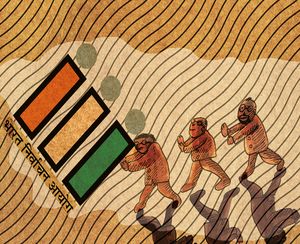What is the biggest mystery about India’s elections? That it involves the largest number of electors? The largest number of parties? The largest number of candidates? The largest number of polling booths? Or that this third world polity of starving millions was the first to introduce universal electronic franchise?
All these are. But the biggest is that our electoral system has been working well with little backing of the law.
I am talking of the model code of conduct, that set of rules which prescribes that ministers’ names and photos shall be removed from ministries’ websites once the polls are proclaimed, that a candidate can have only so many cars escorting him, that he can’t stay in dak bungalows while on campaign trail, that he can’t hold meetings after 10pm, and so on. It is these ‘rules’ that empower a petty district collector to pull the plug on a Union cabinet minister if he goes on orating after 10pm, confiscate a local bully’s car that is carrying currency bundles, or rifle through the boot of the PM’s escort car. It is another matter that some such knights in shining armours have found themselves time-serving in sinecures soon after elections.
None of these rules has any sort of statutory backing. They fall under a ‘model’ of code of conduct which has not been legislated into law. Yet, believe me, most of our political people, whom we call corrupt or criminal, follow the ‘rules’ as gentlemen, and take the little punishments that the monitor, the election commission, prescribes when they are violated.
Now the Supreme Court tells us that not just the model code, but even the appointment of the monitors was being done without enough of constitutional prescription. Indeed, the Constitution says that there shall be an election commission, that it shall be headed by a chief commissioner, that the government may appoint more commissioners if and when required, that the chief will be removed only like a judge through impeachment in Parliament, and so on. To that extent, it has constitutional backing.
But the Constitution doesn’t say how to select the CEC or the commissioners, how they would work when there is divergence of views, and how the commissioners, who don’t enjoy the protection of tenure that the CEC does, can be removed. Yet the system worked well all these 73 years, with agitated persons having had to go to court only thrice.
The first was when V.P. Singh removed the two commissioners whom Rajiv Gandhi had appointed. One of them, S.S. Dhanoa, challenged the executive’s power of removal, but lost the case. The next was when the all-powerful CEC T.N. Seshan went to court against P.V. Narasimha Rao inducting two commissioners. The court read the riot act to Seshan and asked him to better work with the commissioners, or else.
In both instances, the court didn’t find any wrongdoing by the executive. But in the recent Anoop Baranwal case when citizens approached it seeking a law on the appointment and conduct of the commission members, the court decided it got to intervene. Provoking the court was the government’s posting of a civil servant as commissioner within 24 hours of his self-retirement.
Seeking to fill the vacuum left by the founding fathers, the court directed that the commissioners shall be chosen by the PM, the opposition leader and the chief justice sitting together. This shall be the law till Parliament, which alone can make laws, makes one.
Moral of the story: systems will work under good laws; systems will work even without laws, if its managers run them in good faith.
prasannan@theweek.in


